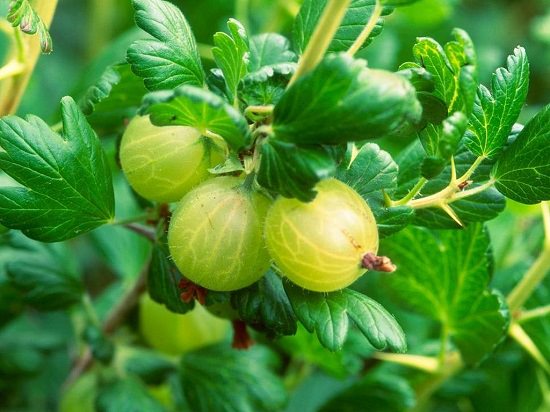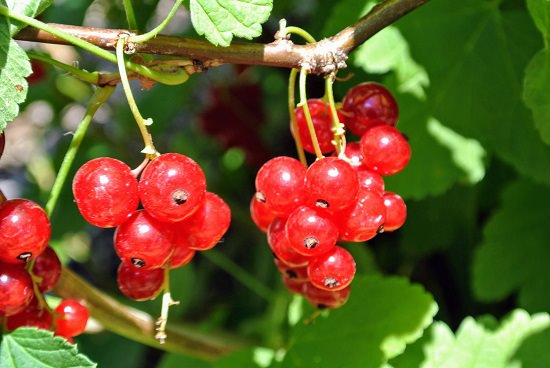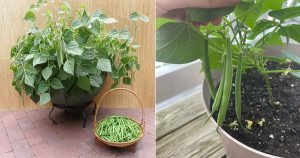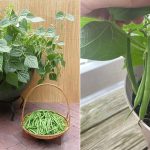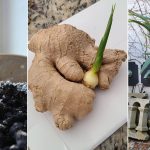One of the most fun things for me is to grow things on my balcony that people wouldn’t believe possible to grow in such a limited space with no “real” dirt. It’s not nearly as difficult as people think, though I have a full sun balcony. What if you dream of canning your own home grown fruit preserves, but have a part-shade balcony or patio? No worries! Look into growing Currants or Gooseberries. And the good news is, according to the Sunset Western Garden Book of Edibles, Fall is the time to plant these berry bushes. You can even wait until winter if you live in a mild winter climate where your containers stay outdoors year round.
Currants and Gooseberries are closely related, attractive shrubs that grow 3-5 feet tall. Currants are thornless and produce either white, black, or red marble-sized fruits. Black currants are sweet while red and white fruiting varieties are more tart. Gooseberries can be thorny, but there are thornless varieties. The fruit can range from dark red to pink to yellow-green and is sweet, perfect for pies and canning.
How Many Plants Should You Buy?
A mature Currant or Gooseberry bush can produce 6-10 pounds of fruit, so unless you plan on feeding a small army solely with berries, you don’t need to line your entire balcony with these berry bushes. That being said, some varieties of Currants are self-fertile, while others need a different variety of Currant (that blooms at the same time) nearby to cross-pollinate with. Read the plant tag or catalog description carefully to determine if the Currant you are considering needs a cross-pollinator. If it does, grow the plants side-by-side, or even better, in the same pot. All Gooseberries are self-fertile, so you’re fine with only one plant, if that’s all you want.
Cold Hardiness
If grown in the ground, Currants and Gooseberries can withstand temperatures as low as -25F or even -40F. But plants in grown in containers have less natural protection from the elements, and for that reason The Bountiful Container recommends keeping them in temperatures above 20F. Don’t rush them indoors though. The deciduous bushes need 600-700 hours of time spent in temperatures below 45F to produce the best fruit (many areas in the southern half of the U.S. will not get cold enough to grow either berry). Only move your plants indoors or provide other extra winter protection when you expect temperatures to stay below 20F for an extended period of time.
Container & Potting Soil
Currants and Gooseberries are shallow rooted bushes, so you only need a pot that is 15 inches deep. One that is wider rather than taller would be best. Choose a good quality potting soil that drains well. When potting up your plant, make sure that the crown of the plant (the main stem of the plant just above the roots) is about an inch below the rim of the pot.
Caring For Currant & Gooseberry Plants
Water your plants deeply (to the point that water flows out the bottom of the pot), about once a week. Water them more frequently in very hot weather or when you see signs of wilting. It is important to water deeply each time to flush out salts that can build up in containers, neither currants nor gooseberries perform very well in soil with high amounts of sodium.
When you plant your Currant or Gooseberry, mix in a fertilizer high in phosphorus (the second number in the sequence of a given fertilizer, i.e. 10-15-15). I like to add liquid kelp at half-strength to my watering can and water all of my plants with it every other week. Reapply the fertilizer you used when you first planted your bushes according to the package instructions (although sometimes with container plants, you need to reapply more frequently, but do so at a diluted strength).
Pruning – When and How
Currants and Gooseberries produce fruit on branches that are two and three years old. This means that a branch that forms in year one will not produce fruit. During year two and three it will produce fruit, and then in year four, the amount of fruit production will drop drastically. This means that you need to leave a branch on the plant for three years and then prune it off.
- (Year 1) During the first season, plant your Currant or Gooseberry and then allow it to grow freely and get established.
- (Year 2) In late winter or early spring–before new growth appears–of the following season, select five or six healthy stems evenly spaced around the bush and mentally or literally mark them as “A.” Prune all other branches off at the base. The branches that you left on the plant are two years old and should bear fruit this season. New branches will also appear during the growing season, these are “B” branches.
- (Year 3) In late winter or early spring, prune off two or three of the “A” branches. Select five or six of the “B” branches that are healthy and evenly spaced around the plant. Prune off all other “B” branches. You should now have three or four “A” branches and five or six “B” branches on the bush. All of the “A” and “B” branches will bear fruit this season. New growth that appears this year should be marked (in your mind or literally) as “C.”
- (Year 4) In late winter or early spring, prune off all “A” branches, and two or three “B” branches. Select five or six evenly spaced “C” branches and prune the rest of the “C” growth off. “B” and “C” will produce fruit this year, mark any new growth this season as “A.”
- (Year 5) Repeat the process of cutting off all of the three year old growth, half of the two year old growth, and selecting five or six of the healthiest one year old branches.
Harvesting
Harvest currants when the entire string of berries in a particular cluster has turned the color of the particular variety you have (black, red, or white/translucent). They will keep for one to two days on the counter, a week in the fridge, or many months if they are properly frozen or dried.
Gooseberries are ready to be picked when they ripen to the appropriate color for the particular variety, and soften slightly. Pick them individually. They will last a little longer than currants, and can also be frozen or dried to prolong their shelf life.
Photo by Fluoride’s memories
Good Varieties for Container Growing
Select a Currant or Gooseberry plant for it’s flavor and disease resistance. Here are some varieties suitable for containers, though this is not an exhaustive list:
- ‘Ben Lomond’ – A variety of black Currant that produces shiny, jet black berries that are sweet-tart and excellent for making preserves.
- ‘Red Jade’ – A red Currant that is very productive. The berries look gorgeous in a bowl on the table and are great for making jam.
- ‘Sweedish White’ – This white Currant variety bears huge crops of attractively translucent berries. You can see the seeds through the fruit when ripe.
- ‘Invicta’ – Produces greenish-yellow Gooseberries in a very disease resistant, but thorny plant.
- ‘Friend’ – A thornless variety of Gooseberry that produces sweet pink fruit to be eaten fresh or used in pies and jams.
Resources
Cornell University has a listing of nurseries selling Currants and Gooseberries. They also have a good growing guide. The University of California, Small Farm Program also has some good info on growing Currants and Gooseberries. And the UC IPM website has some info on pests and diseases common to Currants and Gooseberries.

